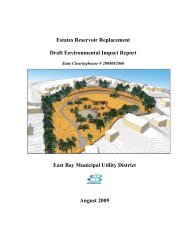Dingee Reservoir Final Seismic Report - East Bay Municipal Utility ...
Dingee Reservoir Final Seismic Report - East Bay Municipal Utility ...
Dingee Reservoir Final Seismic Report - East Bay Municipal Utility ...
- No tags were found...
Create successful ePaper yourself
Turn your PDF publications into a flip-book with our unique Google optimized e-Paper software.
We have tabulated the results for both reservoir surface levels in this section. For estimating the<br />
long-term and current and future seismic stability, we have elected to use storage elevation of<br />
768 feet.<br />
7.3 Long-Term Static Stability<br />
For long-term static stability, a drained analysis with steady state seepage was analyzed for both<br />
upstream and downstream slopes of the dam. For each slope condition, both deep and shallow<br />
failure conditions were evaluated. The analyses were performed using unit weights and effective<br />
strength parameters of the materials shown in Table 4A and 4B, an assumed phreatic line based<br />
on maximum recorded data (since year 2000) of the existing piezometers, and an average-high<br />
reservoir water level (at Elevation +768 feet).<br />
The results of the long-term static stability analysis are shown in Plate 18 for the upstream and<br />
Plate 19 for the downstream slopes. The lowest factors of safety against long-term static stability<br />
for the upstream and downstream slopes are presented in Table 5 below.<br />
Table 5: Long-Term Static Slope Stability Analysis Results – Factors of Safety<br />
Section Upstream Downstream<br />
A-A’ (Water EL = 772 ft) 2.74 1.45<br />
A-A’ (Water EL =768 ft)<br />
1.57<br />
2.31<br />
Block Surface<br />
(See Plate 18)<br />
(See Plate 19)<br />
A-A’ (Water EL =768 ft) NA<br />
1.67<br />
Circular Surface<br />
(See Plate 20)<br />
7.4 Short-Term <strong>Seismic</strong> Stability<br />
A pseudo-dynamic approach was utilized for evaluation of slope stability under seismic<br />
conditions. In this approach, earthquake forces are represented by an equivalent dynamic<br />
horizontal force which consists of the estimated effective horizontal ground acceleration<br />
multiplied by the mass of the potential slide material. For earthquake loading conditions, the<br />
analyses were performed using static total strength parameters as the undrained shear strength for<br />
the materials as shown in Table 4B. No phreatic line was used in these undrained loading<br />
analyses.<br />
Based on the in-situ blow-counts and strength test results, the dam fill materials, native materials,<br />
and the sandstone bedrock are not anticipated to undergo strength loss during cyclic or seismic<br />
loading. As mentioned previously, typical strength increases for rapid loading can be 20 percent<br />
or greater; however, a conservative approach of no strength increase was used for this project.<br />
In the pseudo-dynamic stability analysis, the result is the yield acceleration, K y , an effective<br />
horizontal ground acceleration at which a potential sliding surface would develop a factor of<br />
safety equal to unity. The results of the pseudo-dynamic stability analysis are shown on Plates<br />
<strong>Seismic</strong> Stability Evaluation <strong>Report</strong><br />
<strong>Dingee</strong> <strong>Reservoir</strong> Dam<br />
17<br />
August 2008

















